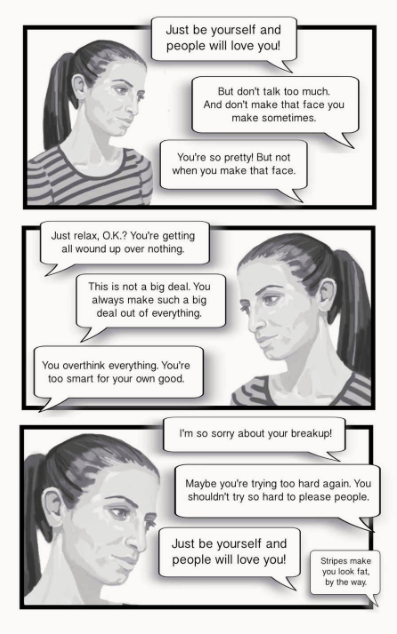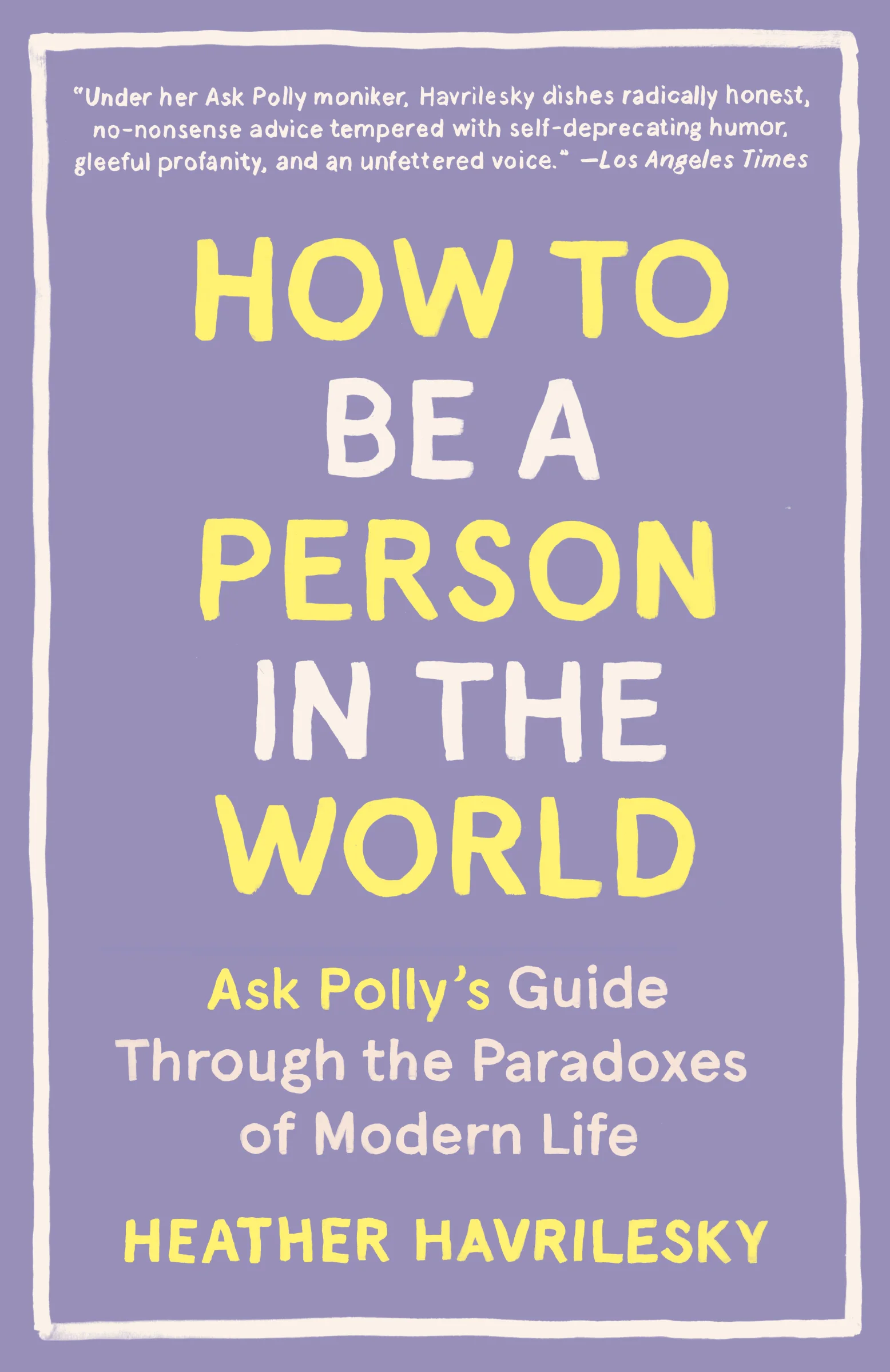Ask Polly's Heather Havrilesky Gives Us Creative Advice

Photo: Willy Somma
Men avoiding you? Getting axed by your employer? Married friends driving you crazy? Polly has the advice you need! Rather, Heather Havrilesky does. Offering insightful help for readers since 2001, Havrilesky currently writes her popular column Ask Polly for New York Magazine. Her book based on the column, How to Be a Person in the World, will be available in paperback Later this month. Havrilesky spoke with Spine about the book, her long and varied history as a writer, and gave us advice for surviving a career as an artist.
You've worked for years as a TV critic, an essayist, and a cartoonist. Why did you start writing an advice column?
I was at a low point in my productivity as a writer and I was craving the structure of a weekly deadline, which I've often had since I started writing professionally in 1995. Once you've written that way for years, it's hard to move on to longer work without having the weekly deadline as a kind of security blanket: "See, I can still write if I need to!" But I really didn't want to immerse myself in TV or movies or books to do it. I love those things, but I was tired of reacting to other people's work. I wanted to write something that felt more immediately worthwhile and also looser, more open-ended and strange. I'd been answering advice letters on my blog for a decade at that point, and I briefly had a jokey advice column for Suck.com way back in 2001. And then Cheryl Strayed's Dear Sugar column really grabbed me by the throat. It was so long and rambling and strange, I loved it. So one day, on a whim, I approached Choire Sicha at The Awl with a pitch: Let me write an existential advice column for you guys, and you only have to pay me enough that my husband won't spit on the floor every time he hears the word "Awl." Choire wrote back DONE immediately and it was on.
How did you decide on the format for your book How to Be a Person in the World: Ask Polly's Guide to the Paradoxes of Modern Life?
Well, I had trouble deciding. I considered writing a straight-up advice book, like almost a self-help book. But one of the editors who bid on the book pushed me to change it into essays without the advice letters, with a lot more cultural content in the mix. I loved that idea a lot, but I wasn't sure how it would work. And when I talked to my eventual editor, Yaniv Soha at Doubleday, he felt strongly that it was absurd to mess with the letter-and-answer format when it worked so well. And I feel like he was right. This column represents the most fun I've ever had as a writer. Why not embrace what it is? So the book is 75% new material with a few favorite previously published columns thrown in.
The book includes some pretty amazing cartoons by Penelope Metcalfe used on the section title pages. How did that happen?
I was pretty fixated on having some kinds of illustrations inside the book, because I needed a way of signaling, design-wise, that this wasn't just a self-help book or a typical collection of advice columns that didn't, say, include a lot of cursing, some rambling personal confessions, and an extended tirade on Kanye West as a muse for women who are sick and tired of lukewarm men. Penelope is my husband's cousin's partner who lives in Sydney and her art is really incredible. We worked together on a series of illustrated Mad Men recaps for The New Yorker, and her work is just brilliant. So I asked her to illustrate some faces, and then I turned her illustrations into the cartoons in the book. They're kind of rudimentary and weird but they add a nice new dimension to things, and a feeling of "Yes, this is heavy shit, but we're trying to have some fun here, too."
Image: Penelope Metcalfe
Did you have an idea of what you wanted the cover of the book to look like?
At first I only knew what I didn't want: Flowers and lipstick and high heels, girly stuff. I like girly stuff, but I wanted a book cover that floated free of gender. So then Doubleday put an owl on the cover. Get it? WISDOM. I hated it with the heat of a thousand suns. It was the absolute worst. Drippy and kind of NPR-crowd weak and wrong. Let me add here that Doubleday has been a complete dream every step of the way and this was, seriously, the one tiny thing that threw me for a loop. What was completely amazing and honestly unexpected was that when they sent me that owl cover, they actually wanted my opinion on whether it worked or not. And so of course I said, "Uh I have to admit I really don't like this," and they (shockingly!) replied, "We weren't sure either. What are you imagining?" So I said what I really wanted was big, sans serif words, ever so slightly '70s-feel to them, and three different cover colors: aqua, bright orange, and chartreuse. I never believed I'd get the three colors, of course, but I basically got exactly what I wanted: aqua with big, plain '70s font. Maybe if the paperback sells out, they'll give me that!
It sounds like you've had bad book cover experiences before?
No, I actually really love both covers of my first book (Disaster Preparedness). Riverhead made good choices with it, but there was much more of a feeling of "Hey, what do you think? Oh, well, you actually don't have any say in this, we were just being polite." But that's absolutely the default in the book world. If you're worried about having no control over your book cover, your editing process, your publicity efforts? You might as well not worry, because you for sure won't have any control. When a publisher is courting you, they'll give you the impression that you'll be guiding the whole process, but nine times out of ten, nope. And to be fair, if you are even the tiniest bit abrasive or avoidant or off your game when you're dealing with your publisher, that can really throw everything off-kilter. You'll speak up, because this is your baby! And then everyone will treat you like a baby for speaking up. First books are tough all the way around. I think the best way to deal with the whole thing is to assume going in that you'll be powerless, and then do your best to be cheerful and energetic and firm about the really important things. The book industry is so bizarre, but let's be fair: People who write alone in a room all day are bizarre, too. Our people skills are often found wanting. We expect too much. We don't always understand the gentle give and take of industrious, busy humans who work among other humans.
So do you have any advice for authors, editors, designers and publicists trying to work together to make a book happen?
Pick up the phone and talk early on in the relationship. I think people put it off too long and then you all become irritants in each other's in box instead of flesh and blood people. And if you can afford to do it, fly out to meet as many of the people involved with your book as you can, soon after you sell a book. I didn't do that with my first book and it was such a mistake! Understanding people's quirks and strengths and accepting just how busy they are really helps. Books are tough to write, tough to edit, tough to sell. You can't go into the whole process as if you're the client and they're the servicer of your needs. You have to be ready to collaborate and compromise. I'm still bad at it! I'm still a brat. But it helps to be realistic, and to be grateful for every bit of attention and energy that you get from your publisher.
And how about some bigger picture advice about surviving your career as a designer or writer or artist in general?
Well, the challenges of producing creative work exert very different forces on an artist than the ones I just described. Getting along with people who work for businesses requires the ability to bite your tongue and muffle your natural enraged nutjob response to the world. But making art is all about letting the spark inside of you start a giant wildfire that could raze a million acres of forest. Creating means letting the darkness in, admitting that you're kind of an asshole, and finding ways to keep your nasty true self around while also shutting her up when you need to. I write a lot about the artist's life in my book, actually – the struggle to balance the madness of creation against the very practical need to form that madness into something that might pay the rent. Like I should mention right now that my paperback comes out on June 27th, but I don't really want to, because it makes me feel like such an annoying shill.
But shills pay the rent.
I guess so. I feel like the whole world is a bad street market where everyone is yelling at you to buy things these days, and I get sick of the people who sell around the clock, so I hate to be one of them. We all feel that way, of course. What can you do? This is the deeply conflicted nature of modern existence. I'm working on a book of essays right now about how impossibly hard it is to be at peace with yourself in the age of social media and Trump and global self-improvement culture, so this stuff is on my mind all the time. And the answer is, you just can't get it perfectly right. But self-consciousness will mute you and put out the spark inside of you completely, so you have to just resolve to screw things up and muddle through and make messes. You have to figure out how to accept that you will never arrive, you'll always just be scraping by with what you have. And maybe there's a way to not just accept that, but to savor it.





